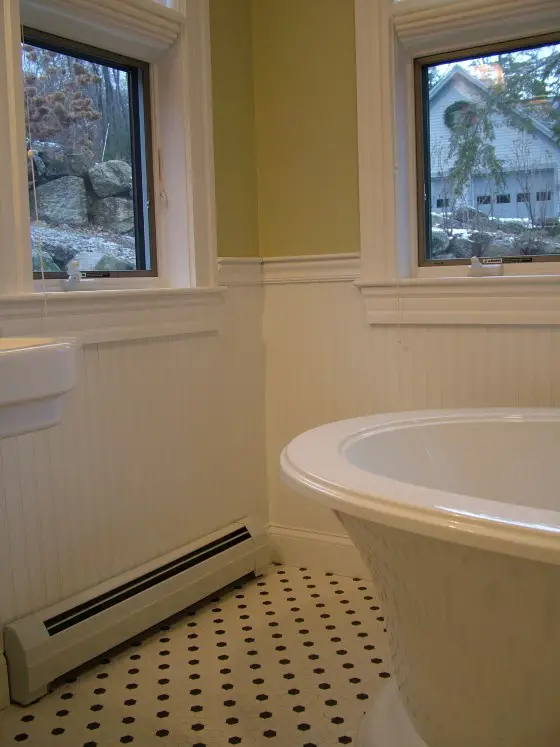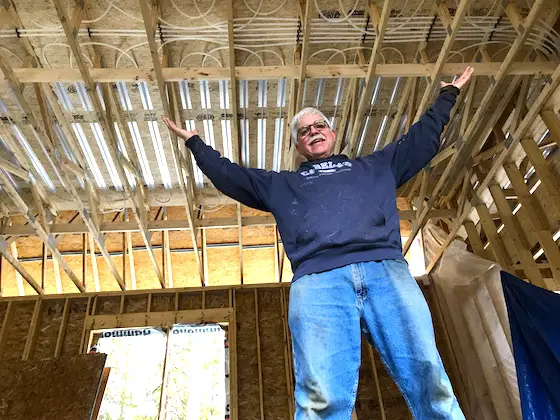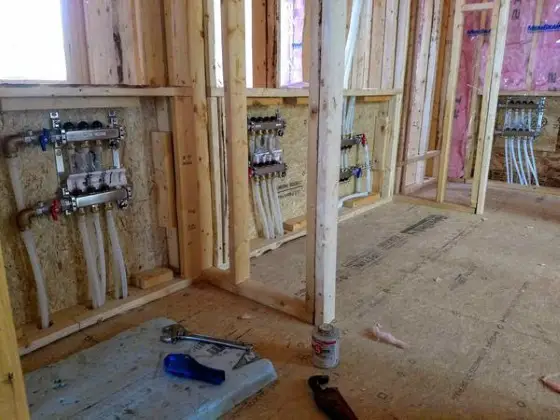What’s in This Issue?
CHRISTMAS TWO WEEKS AWAY!
MARK YOUR CALENDAR
NEW SHOWER IN AN EXISTING BATH
SEVERAL BOOK GIFT IDEAS
GASOLINE ENGINES
MASSIVE STAIN SOLVER NEWS
SEARS CATALOGUE
MY LATEST EBOOK AND FIRST EGUIDE!
VERY COOL WIRELESS VIDEO CAMERA
CHRISTMAS TWO WEEKS AWAY!
Yikes, Christmas is two weeks from today. So much to do and so little time. I remember not too many years back when I would get all stressed out at this time of year and not really enjoy it. Well, now I just go with the flow. I can tell you that I'm much happier. Try it yourself this year and let me know how it works out for you. Because we are now so close to the Holidays, this issue of the newsletter is going to have lots of suggestions of gifts to buy, some being things I have that may be of great interest to you as you jump into projects just after the holidays. One in particular is a new eGuide that can show you how to extend the life of your asphalt-shingle roof.
In the next newsletter I'll get you caught up on past columns as well as some interesting questions I've been getting from people just like you.
MARK YOUR CALENDAR
I'm going to be in Boston again for one day on January 24th. I'll be at the Greater Boston Home Show talking about standby generators AND anything you want me to discuss. If you have problems at your house, bring photos and let's talk about how to fix them. I'll be at the Kraft Power booth from 2 until 4 p.m. However, I'm willing to meet with you before that time and have lunch with you or several subscribers if we just coordinate ahead of time. I'll even do dinner with you and then head back up I-93 to New Hampshire. In three weeks I'll have more information about this. But if you live near or in Boston, this would be a great opportunity for you and I to meet face to face. I would love to meet you.
NEW SHOWER IN AN EXISTING BATH
Heather Cumpston from Highlands Ranch, Colorado emailed me asking, "Hey Tim, We would like to install a shower in an existing ½ bath on the main floor. The basement is finished below. We would need to knock out part of a wall to extend into a room that would become a new bedroom if we're able to put in a shower. From a plumbing aspect is this possible without being real difficult and costly? We would use a prebuilt shower with an inside diameter of 36x36."
Heather, it depends. There are lots of unknowns. For example, what's inside that wall you need to move? Is it a bearing wall? How hard will it be to connect the new shower drain and its vent to the existing plumbing system? I can think of ten other mission-critical questions.
I'm a licensed master plumber, and can tell you that since you have a toilet in this half bath, the drain line has to be at least a 3-inch-diameter stack servicing the toilet. This is a good thing, as the code will allow you to add a shower drain to this stack. How hard is it to make this connection? I can't tell you unless I come out to look at it. But suffice it to say that since it's only 5 feet away and in a ceiling you can access, it's far less expensive than having to break into a slab and make a connection about 30 feet away. I've done that on more occasions than I'd like to remember!
SEVERAL BOOK GIFT IDEAS
Are you looking for three book ideas for gifts? These are totally unrelated, so it gives you lots of latitude for that tough person to buy for. The first one is more a business book, but it also has a strong personal message if you want to succeed at anything. It's called The Success Effect by John Eckberg. I know John, he's a business columnist for the Cincinnati Enquirer. His book is a collection of interviews with some superstars in business. Read each of these interviews, and you're sure to walk away with some inspiration that will help you in your work or personal life.
Are you thinking of building a new home in a few years? Now is the time to start planning the house. Designing Your Perfect House -
Lessons from an Architect is a really swell read. Bill Hirsch is a seasoned architect who has plenty of experience designing custom homes. Wait until you see some of the tips and color photos in this book!
Finally, how about a non-fiction tale of real treasure? Perhaps the richest gold treasure ever brought up from the ocean depths? Ship
of Gold in a Deep Blue Sea is perhaps one of the best books I've read in years. Not only is the story fascinating, but the internal passion of Tommy Thompson to reach his goal is also unbelievable. If you've ever wanted to do something, but think it's too tough, wait until you read this book. WARNING: Rarely do I discover a book I can't put down. This was one of them. It's as if there is a brain magnet inside the pages. This is a fantastic adventure book you may want for yourself to curl up with on a winter's weekend.
If you don't want to buy these, all of them are probably available at your local library or can be had via an inter-library loan.
GASOLINE ENGINES
Yesterday I took delivery of a new John Deere Dual Stage Snow Blower.
It looks like it will munch through the deep snows that are common here in New Hampshire. But I'll report more on that as winter progresses. What I wanted to tell you is the discussion I had with the great mechanic who brought it to me. We were talking about the care of the engine both during the winter and next year when the blower is stored. I thought that what he said would apply to many engines I have that sit idle part of the year.
His advice is for any gasoline engine that you have in your garage or storage shed. I thought it made perfect sense. First, you absolutely must use a gasoline stabilizer when gasoline is stored in the tanks of the engines. The chemistry of the gasoline can change without the stabilizers in as little as 30 days. If this happens, deposits can clog up the carburetors. Also, the mechanic said they have had problems when engines have been run dry of gasoline when stored. Some manuals say to do this. He said it's better to fill the tank, and have gasoline in the carburetor.
Another friend of mine, Mike Mangan - whom you will hear about in a moment - suggested that's it's a great idea to only store one gallon of gas at home at a time. This way you have great odds of having fresh gasoline on hand. Try to manage your inventory so the gasoline you have when you really use the engine is enough to last you just two or three weeks, not two or three months.
But the best advice I thought, was to start the engine every two or three weeks, even in the off season. Allow the engine to run maybe three or five minutes so it's exercised. This is exactly the same thing that is happening with the new standby generator I had installed. It starts up each week so the engine runs on a regular basis.
If you decide to do this, make sure you don't let the engines run in an enclosed space like your garage or a shed. You don't want to be overcome with carbon-monoxide fumes.
MASSIVE STAIN SOLVER NEWS
This will all make sense, so bear with me. I'm a small business. When I testified in front of Congress three times this past summer, I discovered that small businesses make up the lion's share of employment in our nation. I had never really thought about that. Add to this the fact I served over ten years as an appointed government official and as an elected one for two terms of office. What in the world does this have to do with the magical oxygen bleach Stain Solver you ask?
Well, in the county where the Stain Solver warehouse is located, there is an end-of-year inventory tax. As a small business owner, this tax frosts me as it's just another layered cost government adds on to our already stiff tax burden. We small businesses have to pass on that tax on to you. It's hard enough to run a small business and having to raise prices to please the government is hogwash. Well, guess what? We don't have to raise prices - not if we have no product in the warehouse to tax. So I'm doing a true inventory-reduction event.
I want to take my inventory in the warehouse to zero over the next few days with your help. Yes, sell out. That way I can give you the tax money I was otherwise going to give the government. You need the savings now more than the government. I've seen far too much waste in government spending, so I always want to give them less. As an elected councilman, I could tell you stories that would make your blood boil. But I digress.
We did a count at the warehouse. There is only so much material there. I'll not have pricing like this for a while, so you don't want to miss out. I'm only offering the special price on my two largest sizes, as I want to move massive amounts of the product. I want to sell out now and then restock on January 2, 2009 so I can avoid the tax.
I've told Ellen and Roger to slash the price 30 percent on the 16 and 50-pound sizes of Stain Solver. The other sizes are NOT on sale. With this pricing, I guarantee you we will sell out in days. There are only 135 of the 50 pounders in the warehouse and 150 of the 16 pounders. If you don't react fast enough, you will see an Out-of-Stock message at the shopping cart. Come back on January 2, 2009, and we will be selling those sizes again, but not at the reduced price. I urge you to take advantage of this sale. I will not be offering this discount to those that show up late to the sale. Hurry please so you're not disappointed.
SEARS CATALOGUE
Years ago, I met a great friend. His name is Mike Mangan. Mike has done public relations for Sears for years. He's a real pro. If you're looking for some really great Christmas gifts for your loved ones, Sears might have some specials for you in the Sears Christmas Holiday Tool Gift Guide. Go and act quickly.
MY LATEST EBOOK AND FIRST EGUIDE!
I finished my latest eBook a few days ago. If you want to discover how I install and grout a ceramic-tile floor or a slate floor, this is what you need. To be honest, I feel it's my best eBook ever. It's loaded with detailed color step-by-step photos, and is by far, the longest eBook I've ever written. The photos in the actual eBook are links to high-resolution photos so you can really see what's going on.
To get an idea for yourself of its quality and depth of information, you can download a free chapter of the eBook. That way you can see what goes into these neat documents. Years ago I made a pledge that when I introduced a new eBook, I would give you a discounted price when it was first rolled out. The regular price is going to be $19.97, but you can get this new eBook for just $14.97 until Monday morning December 15, 2008.
But stop, it gets better, I also finished my first eGuide this week. These are new shorter publications that will help you conserve money in these times of hardship. This first eGuide is for anyone who has a standard three-tab asphalt shingle roof. You'll be able to see a photo of what that is in a moment. Both the eBook and the eGuide are instant download PDF documents. I don't mail you a hard-copy book. You download these things and decide yourself if you just want to view it on your computer or print off your own copy. Within a minute or two of placing the order, you get an email with links you click to get your documents. This is a very green thing to do. It saves lots of energy, and you get the information almost instantly.
Right now, you may be one of the tens of thousands of people who can't afford a new roof. What if I told you there was a simple thing you could do to extend the life of your existing three-tab shingle roof by ten or even fifteen years? That way when money comes available, you can install the new roof. This eGuide, with its own step-by-step color photos, shows you how to do that. The cost of the Roofing eGuide is just $4.97.
But if you purchase the Slate eBook at the discounted price of just $14.97 on or before 7:00 a.m. December 15, 2008, I'll give you the Roofing Guide at no cost to you. So you get both documents as Instant Downloads for just $14.97. But you need to act now.
If you do this, remember that you get TWO emails from the shopping cart. The one will say STAINSOLVER and ASKTHEBUILDER. Ignore that one. The second one will have the links that allow you to download both documents.
I guarantee you'll be satisfied. Remember, the eBook says it's for a Slate floor because at the time, that's what I was installing. But the techniques are the SAME for ceramic tile. All of the step-by-step information in the eBook applies if you're going to do a tile floor. The price is so attractive I guarantee you'll discover tips you've never heard before. Oh, I almost forgot!!!!! In the Forward of the eBook there is a photo of me from 38 years ago with my hair down to my shoulders. That alone may be worth the purchase price to you. Ha Ha!!!
VERY COOL WIRELESS VIDEO CAMERA
This past weekend I tested a really cool Lorex LNE3003 wireless, network ready, day/night webcam that's very easy to set up out of the box. I say that if you use a PC instead of a Mac or Apple computer. I use a Mac, so I had to switch to a PC to get the software to run.
This little dandy camera allows you to remote view while you are in the house or remote view if you are away from the property. If you have an iPhone, you can even view the camera in real time with your phone. The camera can be operated wired into your network or beam its signal wirelessly.
The camera has some amazing features that you may find interesting. I urge you to go look at this product. It would make a cool gift for someone, even yourself.
Index of past newsletters.








